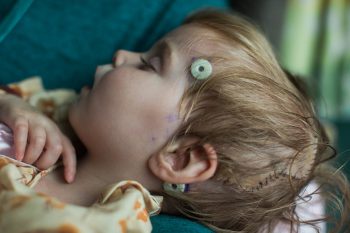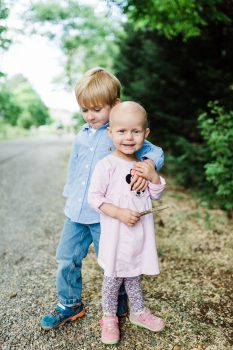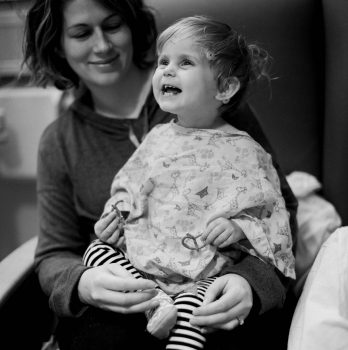
Recalling the treatments her daughter has had over the past year for an aggressive, very rare type of brain tumor known as atypical teratoid rhabdoid tumor, or ATRT, Audrey Taylor says it’s like watching a game where your favorite sports team keeps losing and then regaining the lead.
“There are so many times when you feel like you totally got this, followed by moments where you’re not really sure what’s going to happen next,” she said.
Diagnosed with ATRT at 21 months old, Danica Taylor, now 3, has endured multiple rounds of chemotherapy, stem cell transplants, two brain surgeries, laser ablation and proton beam radiation therapy to try to stop the fast-growing tumor.
Danica remained strong through it all.
“She’s just the bravest and toughest kid I know,” Taylor said. “Whenever I have to do something hard, I summon my inner Danica.”
The ‘beast’

Then, last fall, the Taylors suddenly found themselves down in the game once again against ATRT.
A follow-up magnetic resonance imaging (MRI) scan showed an abnormality in the same area of Danica’s brain where the tumor was first found. It wasn’t clear from the scan whether the area in question was tumor or scar tissue from the radiation. The team from Seattle Children’s Brain Tumor Program recommended surgery for the second time.
“While I didn’t want to put her through surgery again, I agreed with them that if this was ATRT, I wanted it out,” Taylor said. “Parents of children with ATRT refer to the disease as a beast. You have to hit it with everything you can.”
Pivotal trial tests new tool for precisely imaging childhood brain tumors during surgery

For most of the more than 4,000 children like Danica who are diagnosed with brain or central nervous system tumors in the United States each year, surgery to remove the tumor is the most important aspect of their treatment.
“The biggest factor making a difference in the life of a child with a brain tumor is the success of their surgery,” said Dr. Sarah Leary, a pediatric neuro-oncologist at Seattle Children’s. “Anything we can do to make surgery safer or better not only impacts survival, but the quality of survival.”
Leary serves as the lead investigator of a phase 2/3 clinical trial evaluating tozuleristide (BLZ-100, also referred to as Tumor Paint), a tumor-targeting fluorescent imaging agent that aims to improve surgical outcomes in children with brain tumors.
By acting as a molecular flashlight, the drug is designed to enter into tumor cells, which assists a surgeon’s ability to visibly distinguish tumor from normal brain tissue when viewed with the Canvas Imaging System, an investigational light attached to the surgical microscope. This added information may prove especially useful in the most challenging areas of brain surgery, such as identifying the precise edges of a tumor, where there is sometimes uncertainty using current methods.
With support from the Norcliffe Foundation and Gateway for Cancer Research, the study is now enrolling children undergoing brain surgery for central nervous system tumors at Seattle Children’s, and soon to open at up to 14 other leading pediatric brain tumor centers in the U.S. as part of the Pacific Pediatric Neuro-Oncology Consortium (PNOC).
“There is currently no imaging agent approved for children with brain tumors even though a fluorescent technology exists for adults with a certain type of brain tumor,” Leary, a member of Seattle Children’s Center for Clinical and Translational Research, said. “Brain tumors in children are not just little adult tumors. They have a different biology. The drug and device in this study are exciting because they were specifically designed to improve surgical outcomes in children with brain tumors.”
Tumors glow in real-time under new microscope

Results from a phase 1 study of tozuleristide completed at Seattle Children’s showed that over 80% of pediatric tumors evaluated safely “lit up” using the imaging agent. The phase 2/3 trial will enroll 114 patients across all sites to assess the safety and efficacy of the drug, which was invented by a team led by Dr. Jim Olson, pediatric neuro-oncologist at Seattle Children’s and Fred Hutch, and co-founder of Blaze Bioscience: The Tumor Paint Company.
With the addition of the Canvas Imaging System in this phase of the trial, Dr. Amy Lee, the lead neurosurgeon on the trial, believes the drug and device combo have great potential in the operating room.
“It offers an additional tool that’s easy to use during surgery where, with the flip of a switch, I can get information to help guide my decisions about what to remove when I’m at the tumor’s borders or in other questionable areas,” said Lee. “At the end of this trial, if we can say the drug and device are safe and effective, I would absolutely use it in every instance where there is ambiguity in discerning between tumor and healthy tissue.”
Danica gets a dose of ‘cancer kryptonite’
Just as Taylor began making preparations for Danica’s second surgery with neurosurgeon Dr. Richard Ellenbogen in November 2018, a friend told her about tozuleristide. Taylor wanted to know if Danica would be a candidate for the trial, which was set to open at Seattle Children’s later that month.
“I immediately asked Dr. Ellenbogen to put me in touch with the doctors leading the trial so I could learn more,” Taylor said. “As far as I was concerned, in the hands of a very experienced surgeon like Dr. Ellenbogen it seemed this new tool would only amplify the potential of a successful surgery for Danica.”
Danica became the first patient enrolled on the phase 2/3 trial just hours after it opened for enrollment. She was randomized to go on the treatment arm of the study and one day before her surgery, she received a single dose of tozuleristide intravenously.
“We hope that tozuleristide can offer an added layer of assurance for any child undergoing brain tumor surgery,” said Ellenbogen. “In Danica’s case, our team was interested in seeing if tozuleristide could help lead us to the abnormality on her MRI scan almost like a firefly lighting the way.”
In Danica’s procedure the next day, Ellenbogen removed the abnormality using guidance from the Canvas Imaging System and other standard navigational tools in the operating room. When pathology came back that no tumor cells were present, the Taylors were overjoyed.
“It was huge,” Taylor said. “I am deeply appreciative of the efforts and hard work of Danica’s brain tumor team. They saved my girl’s life.”
One step closer to a cure

Aggressive brain tumors like ATRT remain some of the most obstinate childhood cancers to overcome with survival rates hovering below 50%.
Leary, Lee, Ellenbogen and the other experts that make up the Brain Tumor Program at Seattle Children’s are helping move the needle to improve survival in difficult to cure brain tumors, offering more than a dozen clinical trials with treatments not available at many other pediatric hospitals. In addition to tozuleristide and the Canvas Imaging System, other innovative technologies such as laser ablation and the ROSA ™ robotic surgical assistant provide minimally-invasive options for children for whom surgery provides the best route to a cure.
If successful, the tozuleristide trial may also offer the first step in finding a better way to treat brain tumors in children.
“The goal in developing tozuleristide was not only to light up tumors, but once we light them up, to explore if we could use it to deliver a therapy that would kill the tumors,” said Ellenbogen, who is also one of the co-inventors with Olson. “At this stage, we still have to prove that it finds tumor. But the beauty of where we are now is that it gives families hope that we are one step closer to a potential cure for more pediatric brain tumors.”
For more information about the Phase 2 trial of tozuleristide underway at Seattle Children’s, please call 206-987-2106 or email [email protected].
Resources
- Learn more about the study at Seattle Children’s
- Blaze Bioscience press release about phase 2 clinical trial
- Gateway for Cancer Research press release on completion of phase 1 study

